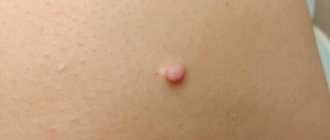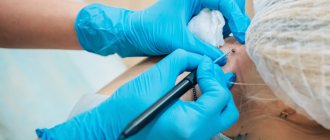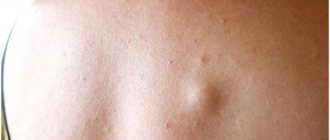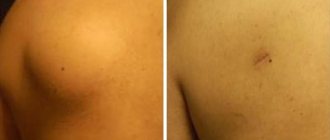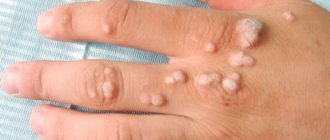Suppurating atheromas are a disease represented by the presence of a cystic formation on the surface of the skin.
In the absence of an infectious process, the cyst looks like a small round wen with clear edges.
Any mechanical injury can lead to damage to the epidermis and, accordingly, to the development of atheroma. In this case, the disease progresses and affects nearby tissues.
Festering atheromas can reach the size of a chicken egg, causing considerable discomfort to the owner.
What is atheroma
Atheroma (or trichodermal cyst) is a benign tumor-like formation related to epithelial cysts of the skin and formed as a result of blockage of the excretory duct of the sebaceous gland.
Atheroma is a round capsule sac filled with a thick white or yellow mass with an unpleasant odor. The content of atheroma is keratin protein, which is produced by its walls. Men are more susceptible to the formation of atheromas (due to oilier skin) than women, and formation is also more common in middle-aged and elderly people than in young people. As for location, atheroma can occur on any part of the body, but most often occurs where there are especially many sebaceous glands - on the back between the shoulder blades and on the shoulders, scalp, on the back of the neck, face, buttocks or in the genital area .
Diagnostics
The diagnosis is made by a dermatologist, surgeon or general practitioner. Most often, a general examination is sufficient for diagnosis, since the appearance of the formation has characteristic features.
In rare cases, for differential diagnosis with other benign formations - fibroma, lipoma, hygroma - ultrasound is recommended. This reveals a dense capsule and liquid contents of the cyst.
Since the risk of atheroma degenerating into a malignant tumor is extremely low, a biopsy is usually not recommended. After its removal, a histological examination of the capsule can be performed. The result takes 10-14 days to prepare.
Causes of atheroma in adults
Experts identify several causes of atheroma:
- hormonal imbalance;
- metabolic disease;
- structural defects of the sebaceous glands;
- damage to the hair follicle, which disrupts the outflow of secretions;
- trauma to the sebaceous gland (when squeezing out a pimple, scratching, infection);
- Gardner's syndrome (a fairly rare hereditary genetic disease);
- neglect of personal hygiene rules.
Reasons for education
A cyst can appear for various reasons, including:
- disruption of the functioning of the sebaceous glands, manifested by insufficient exfoliation of the skin, hyperhidrosis, seborrhea or persistent keratinized cells, as well as high viscosity of sebum;
- problems with the endocrine system;
- negative environmental impact (for example, working in conditions of constant pollution with various irritants);
- difficulties with the urinary system;
- failure to comply with hygiene rules;
- low-quality cosmetics that narrow the ducts of the sebaceous glands (in particular, deodorants and antiperspirants), various cosmetic procedures (hair removal and depilation);
- inflammatory processes on the skin, as well as;
- damage to hair follicles.
The consequence of the above factors can be not only atheroma, but also other skin ailments.
Symptoms of atheroma in adults
Atheroma has clear boundaries, dense and elastic to the touch. It is located directly under the skin and moves freely under it if you gently press it with your finger. The color of the skin in the area with atheroma is usually not changed, but with rapid growth it may turn red or become covered with ulcers. Sometimes an enlarged duct of the sebaceous gland is noticeable on the atheroma, and if the atheroma communicates with the skin, then through this duct cheesy white, grayish or yellowish masses with an unpleasant odor can be separated - sebum. The atheroma itself is absolutely painless, and if it is small in size and does not increase, it does not cause any physical discomfort, although from the outside it may look like a significant cosmetic defect.
Atheroma is
A neoplasm on the skin of cystic origin, which is a consequence of blockage of the sebaceous gland duct. The cyst appears in those areas of the body where hair grows: head, face, neck, back, genital area. Usually people are very worried about atheroma on the neck, the removal of which is necessary in the same way as if they are localized in other places.
What does atheroma look like (photo)
The neoplasm has clear contours, is mobile, and looks like a dense ball with lard-like contents. In the center of the cyst, you can notice a tense, swollen point, which is a blocked outlet of the sebaceous duct.
As for pain, only during suppuration the patient will feel pain; otherwise, there is no such factor. In addition, in case of suppuration, swelling, redness, and fever occur. It is worth considering that sometimes atheroma breaks out on its own, releasing pus along with the contents of the sebaceous glands.
If you need to undergo surgery to remove atheroma in Moscow, the Yuzhny clinic is the right option to go to for quality medical care.
Treatment of atheroma in adults
A surgeon treats atheroma. The main thing is to never self-medicate or open the atheroma yourself, so as not to cause an infection.
Diagnostics
Diagnosis of atheroma usually does not cause any difficulties. At the appointment, the doctor conducts a visual examination of the formation and surrounding areas of the skin. A distinctive feature of atheroma is its painlessness and the presence of an enlarged duct of the sebaceous gland.
However, it is important to distinguish atheroma from lipoma or hygroma, which, despite their external similarity, require completely different treatment. If necessary, after surgical removal, fragments of atheroma are sent for histological examination.
To the point
Angioma in adults: what is it and how can it be cured at home
Modern methods of treatment
Modern methods of treating atheroma involve only its removal - laser or radio wave removal, or classic surgical removal using a scalpel.
Removal of atheroma is carried out under local anesthesia: the skin is carefully cut with a scalpel, after which, using gentle pressure, the atheroma and its capsule are squeezed out, after which the wound is treated and a couple of stitches are applied.
If the atheroma is severely inflamed and an abscess has formed, then sometimes treatment is carried out in two stages to prevent recurrence of the atheroma. First, the surgeon opens the abscess and drains it, and when the inflammation decreases, the remaining formation is removed and sutures are applied.
What may worry a patient after surgery?
Serious complications after removal of atheroma are extremely rare. However, some patients may experience some discomfort, which is within normal limits and passes quickly.
- Like fibroid removal, atheroma enucleation may cause a slight increase in body temperature. This occurs if the operation was performed against the background of a cold or exacerbation of a chronic disease. This is very rare, since the doctor diagnoses the patient’s condition before the operation.
- There may be some swelling at the removal site.
- Accumulation of fluid in the subcutaneous tissue. This phenomenon is combated by applying a pressure bandage or inserting a drainage tube.
- Secondary infection of the seam if the doctor’s recommendations and hygiene rules are not followed.
Complete healing of the scar after cyst removal takes no more than 3 months. During this time, the scar completely resolves and disappears. To speed up this process, the doctor may prescribe special ointments that promote healing.
Prevention of atheroma in adults at home
There are no specific methods for preventing atheroma, but since it is more likely to form in oily skin, you need to pay attention to hygiene issues - take a shower more often, consult a dermatologist who can prescribe special products to reduce oily skin.
This is interesting
What to do if a boil pops up: advice from doctors
It is also necessary to wear clothes made from breathable natural fabrics, not synthetics, and monitor your diet, excluding fatty and smoked foods, spicy seasonings and carbonated drinks.
Possible methods of dealing with scars after removal of atheroma
It is possible to remove a scar after atheroma with the help of cosmetology, physiotherapy, and home applications with anti-scar agents. In extreme cases - with surgical intervention.
Cosmetology involves traumatizing the stratum corneum of the skin in order to renew it. This could be chemical peeling, dermabrasion, etc.
Applications are made with special anti-scar creams, gels and ointments 3-5 times a day. They are effective for small, fresh scars. Their combination with physiotherapy is effective.
Physiotherapy offers a course of electro- and phonophoresis procedures - exposure of the scar to electric current or ultrasound. These manipulations stimulate metabolic processes, improve blood circulation, and when combined with anti-scar agents help to significantly speed up the process of tissue regeneration. In this case, the main task of physiotherapy is to transfer particles of the medicinal substance into the deep layers of the skin.
Surgery is prescribed in extremely severe cases, for example, when the keloid scar has reached enormous sizes. After excision of the scar, the wound should heal, and therefore a new scar will appear at the site of the skin injury. With proper rehabilitation, it is normotrophic (light and flat). However, the risk of keloid recurrence is very high.
Possible complications
The most common complication of a neoplasm is suppuration of the cyst, which indicates the addition of a bacterial infection. After this, the following symptoms appear:
- secondary inflammatory process;
- development of suppuration on the skin and subcutaneous tissue;
- spontaneous opening of the cyst or self-removal, after which it forms again;
- scars appearing after unauthorized removal of the tumor.
It is extremely rare that a benign neoplasm is modified into a malignant one. It is worth noting that retention cysts never develop into this state.
If the atheroma is not treated, its surface can break through on its own, releasing thick pus with a sebaceous mass. Further, if the infection spreads to adjacent tissues, phlegmon may develop - purulent inflammation without clear boundaries. This situation is considered dangerous, and an emergency operation is performed in which the cyst is only cleaned.
If you need to undergo surgery to remove atheroma, Moscow is your region - do not delay your visit to the doctor until possible complications arise. Removing a clogged sebaceous gland at an early stage is guaranteed to produce results, preventing the deterioration of the patient’s health condition, the occurrence of relapses, and, above all, an excellent visual effect is noticeable. This is all thanks to the highly qualified specialists who work in the medical field.
Consultation regarding removal of atheroma
Of great importance when consulting about the removal of atheroma is obtaining reliable information about the possible risks of the operation and the circumstances of the postoperative period. The surgeon learns the presence of concomitant diseases, such as diabetes; taking medications the day before (aspirin, warfarin) that affect the blood coagulation system may be a contraindication to surgery, and the surgeon must be notified of all such circumstances. The consultation also includes an examination, possibly in the dressing room.

